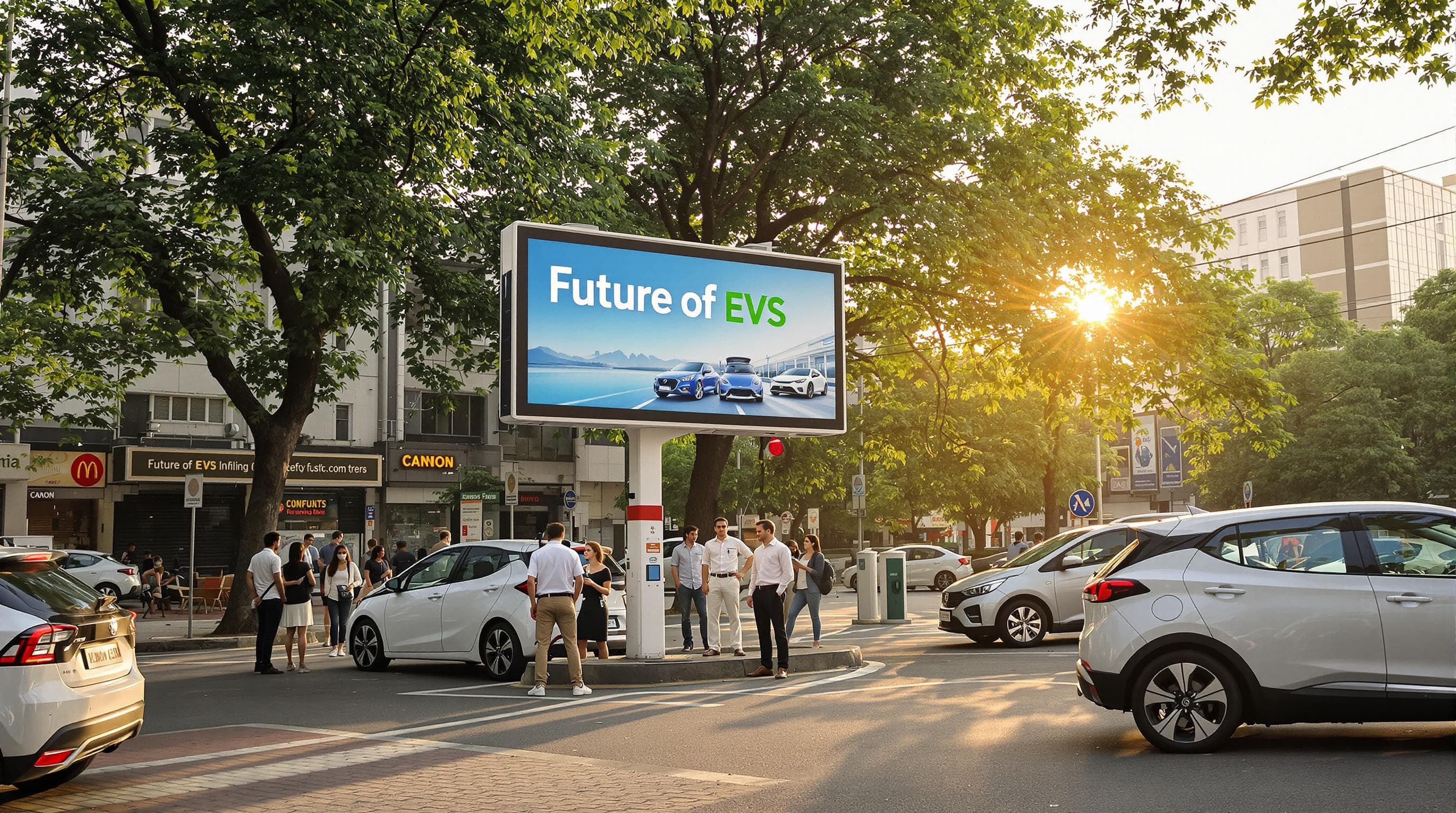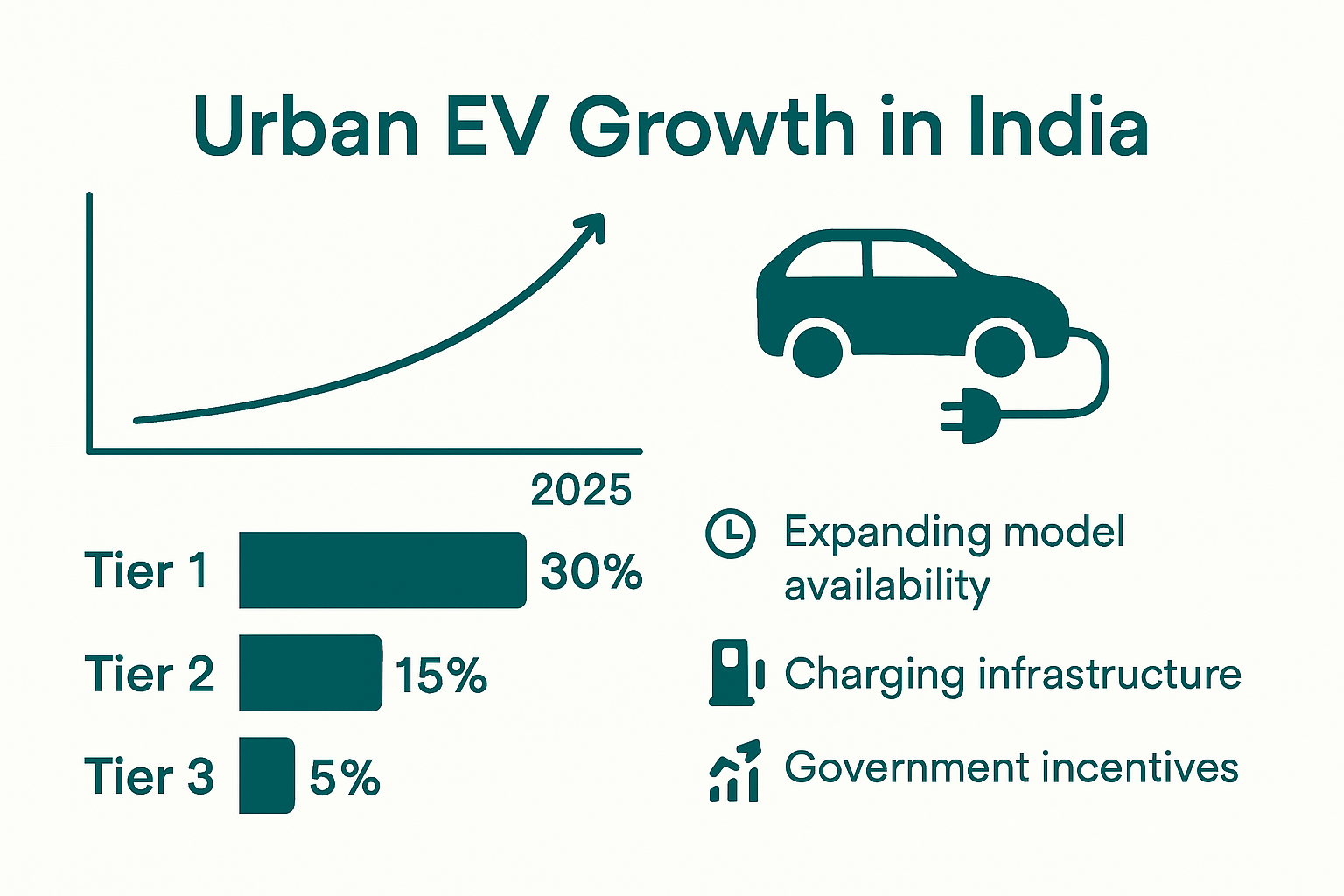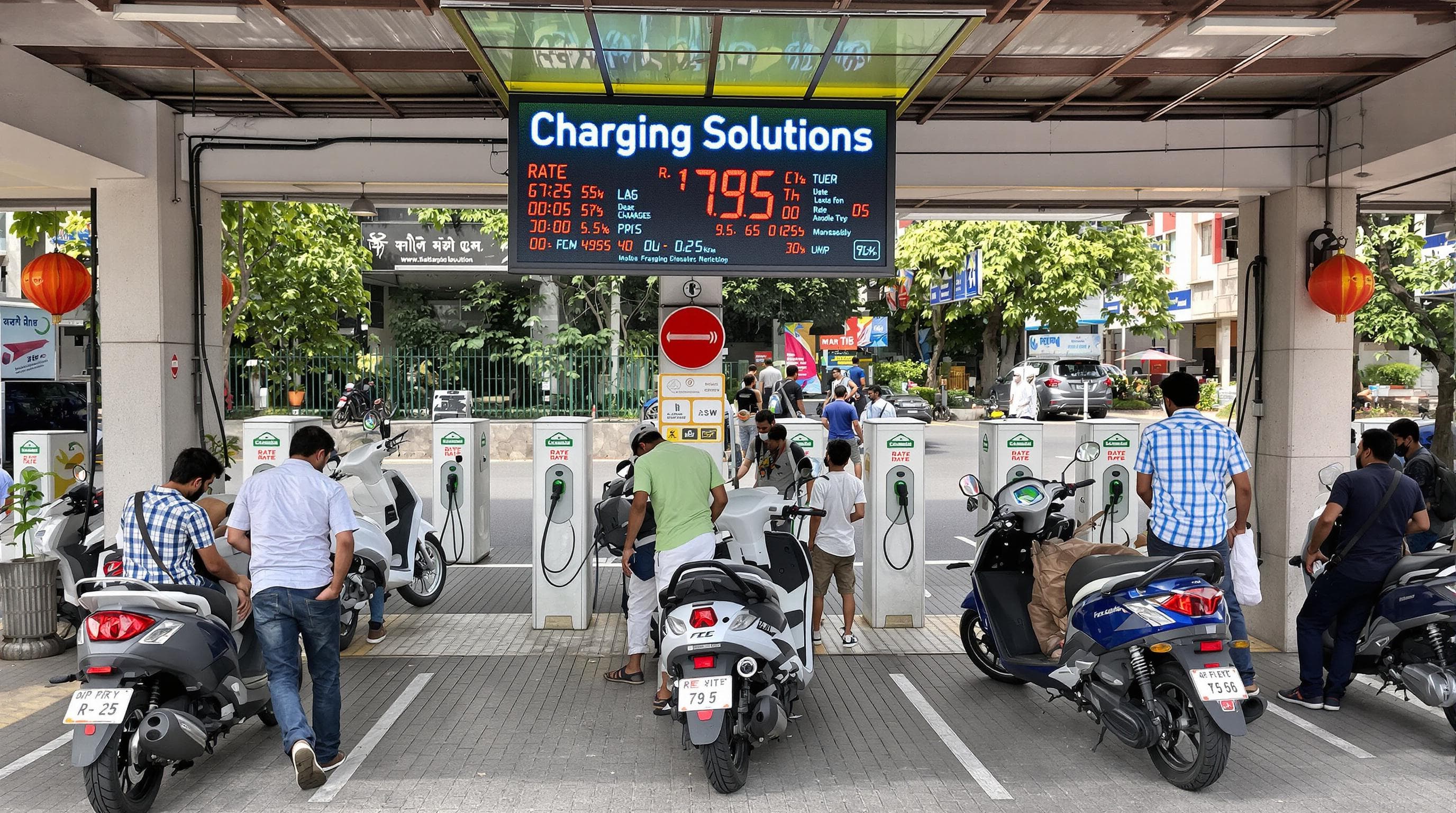
Electric vehicles are taking over Indian cities at a pace few predicted, with Tier 1 cities on track for a 13 percent EV market share by 2025 and smaller cities close behind. Here’s the twist. Despite flashy tech upgrades and bigger government pushes making headlines, the real surprise is just how quickly daily life for millions of commuters is set to change. The path to that future is not just about new vehicles, but about how towns, tech, and cash incentives collide to redraw the rules of urban mobility.
Table of Contents
- Electric Vehicle Adoption Trends In Indian Cities
- Government Policies Shaping The Ev Future
- Upcoming Ev Technologies And Infrastructure
- Opportunities And Challenges For Urban Commuters
Quick Summary
| Takeaway | Explanation |
|---|---|
| Urban EV Adoption is Rapidly Growing | By 2025, Tier 1 cities are expected to have a 13% EV market share, and Tier 2 and 3 cities are following closely with 10.67% and 8.68%, respectively, driven by younger populations and stricter emissions regulations. |
| Government Support is Key to EV Expansion | Initiatives like the PM E-DRIVE scheme and Production Linked Incentive (PLI) aim to promote EV adoption through financial incentives, infrastructure development, and domestic manufacturing growth. |
| Infrastructure Development is Critical | The plan to install over 72,300 charging stations aims to alleviate range anxiety, making long-distance electric travel feasible and attractive for urban consumers. |
| Technological Innovations Are Transforming the Market | Advancements in battery technology, such as Battery Swapping and improved energy solutions, are addressing key barriers to EV adoption, including cost and charging time. |
| Economic Dynamics Favor EV Adoption | Lower operational costs and government subsidies are making EVs increasingly competitive, especially for two-wheelers and compact vehicles, which are particularly appealing for budget-conscious commuters. |
Electric Vehicle Adoption Trends in Indian Cities
Electric vehicle adoption in India is experiencing a transformative journey, with cities emerging as critical battlegrounds for sustainable transportation transformation. The future of electric vehicles hinges on urban centers driving innovation, infrastructure development, and consumer acceptance.
Urban Dynamics Shaping EV Growth
Indian cities are witnessing unprecedented momentum in electric vehicle penetration. Recent data from economic research indicates that metropolitan areas are experiencing significant shifts in transportation preferences. By 2025, Tier 1 cities are projected to reach approximately 13% EV market share, while Tier 2 and Tier 3 cities are rapidly catching up with 10.67% and 8.68% penetration rates respectively.
The urban landscape is particularly receptive to electric vehicles due to several compelling factors. Younger populations in metropolitan areas demonstrate greater environmental consciousness and technological adaptability. Additionally, escalating urban pollution levels and stringent emissions regulations are pushing city administrators and residents toward cleaner transportation alternatives.

Infrastructure and Policy Catalysts
Cities like Delhi are pioneering comprehensive EV adoption strategies. According to policy analysis, Delhi’s innovative policy framework has propelled its EV penetration to 11.5% in fiscal year 2024. This remarkable achievement stems from a multifaceted approach including purchase subsidies, tax rebates, and vehicle scrapping incentives.
Charging infrastructure plays a pivotal role in urban EV adoption. Metropolitan areas are strategically expanding public charging networks, transforming potential barriers into opportunities for electric mobility. Research highlights that the number of charging stations directly correlates with consumer confidence and vehicle adoption rates.
Emerging Market Segments
Urban electric vehicle adoption is diversifying beyond personal transportation. E-commerce and delivery sectors are rapidly electrifying their fleets, creating substantial momentum. Two-wheelers and three-wheelers are experiencing exponential growth, particularly in metropolitan areas where short-distance commuting dominates.
Interestingly, this trend extends beyond traditional markets. Cities are witnessing electric vehicles penetrating segments like logistics, public transportation, and last-mile connectivity. The economic incentives combined with environmental benefits are making electric mobility an attractive proposition for businesses and individual consumers alike.
For those interested in exploring affordable electric vehicle options, check out our comprehensive guide on budget-friendly electric cars that are reshaping urban mobility landscapes.
As Indian cities continue to evolve, electric vehicles are not just a technological transition but a comprehensive urban transformation. The future of mobility is being written in the bustling streets of India’s metropolitan centers, one electric vehicle at a time.
To clarify the growth of electric vehicles across different city tiers, here is a table summarizing EV penetration rate statistics mentioned for 2025:
| City Tier | Projected EV Market Share by 2025 |
|---|---|
| Tier 1 Cities | 13% |
| Tier 2 Cities | 10.67% |
| Tier 3 Cities | 8.68% |
| Delhi (FY2024) | 11.5% |
Government Policies Shaping the EV Future
The Indian government is strategically positioning itself as a catalyst for electric vehicle transformation through comprehensive and forward-thinking policy interventions. These policies are not merely regulatory frameworks but sophisticated roadmaps designed to accelerate India’s transition towards sustainable mobility.
National Electric Mobility Mission
The government’s commitment to electric vehicles is exemplified by groundbreaking initiatives like the PM Electric Drive Revolution in Innovative Vehicle Enhancement (PM E-DRIVE) scheme. Launched in October 2024, this ambitious program allocated ₹10,900 crore specifically to promote electric vehicle adoption through strategic subsidies and comprehensive charging infrastructure development.
Central to these policy efforts is a multi-pronged approach targeting consumer incentives, manufacturing support, and infrastructure expansion. The government recognizes that transforming India’s transportation ecosystem requires synchronized interventions across multiple domains. By providing financial incentives, reducing GST rates, and offering purchase subsidies, policymakers are systematically lowering barriers to electric vehicle ownership.
Manufacturing and Investment Incentives
The Production Linked Incentive (PLI) Scheme for the Automotive Sector represents a cornerstone of India’s electric vehicle strategy. With a substantial budget of ₹25,938 crore introduced in September 2021, this initiative aims to boost domestic manufacturing of advanced automotive technologies, including electric vehicles and critical components.
This policy framework is designed to attract significant domestic and international investments, positioning India as a global manufacturing hub for electric mobility solutions. By offering financial incentives linked to production volumes and technological sophistication, the government is encouraging manufacturers to develop cutting-edge electric vehicle technologies within the country.
Regulatory Framework and Environmental Goals
Beyond financial incentives, the government is implementing stringent regulatory measures to accelerate electric vehicle adoption. Emission standards, mandatory electrification targets for public transportation, and progressive urban mobility policies are creating a comprehensive ecosystem supportive of electric vehicles.
Local governments are complementing national strategies by introducing city-specific EV policies. Initiatives like preferential parking, reduced registration fees, and dedicated charging zones are making electric vehicles increasingly attractive for urban consumers. For more insights into emerging EV technologies, explore our detailed industry analysis.
These coordinated policy efforts reflect a holistic approach to sustainable transportation. By addressing manufacturing, consumer incentives, infrastructure development, and environmental goals simultaneously, the Indian government is crafting a robust blueprint for electric mobility’s future.
As policies continue to evolve, the synergy between government initiatives, technological innovation, and market dynamics will be crucial in determining India’s electric vehicle trajectory. The next few years are poised to be transformative for electric mobility in the country.
Below is a table summarizing major government EV policy initiatives, their launch year, and allocated funding as discussed in the article:
| Policy Initiative | Launch Year | Allocated Funding | Focus Areas |
|---|---|---|---|
| PM E-DRIVE Scheme | 2024 | ₹10,900 crore | Purchase incentives, charging infra, subsidies |
| Production Linked Incentive (PLI) Scheme | 2021 | ₹25,938 crore | Domestic manufacturing, technology development |
| GST Rate Reduction & EV Subsidies | Ongoing | Not specified | Lowering EV purchase cost for consumers |
Upcoming EV Technologies and Infrastructure
The electric vehicle landscape in India is rapidly evolving, driven by groundbreaking technological innovations and strategic infrastructure development. As the nation positions itself at the forefront of sustainable mobility, emerging technologies are set to revolutionize how Indians perceive and interact with electric transportation.
Battery Technology and Energy Solutions
Battery technology stands as the cornerstone of electric vehicle advancement. Our comprehensive guide on EV battery innovations highlights the transformative potential of next-generation energy storage solutions. The Ministry of Power has been particularly proactive, introducing innovative concepts like Battery as a Service (BaaS), which addresses two critical challenges in EV adoption: initial vehicle cost and range anxiety.
According to recent infrastructure guidelines, battery swapping stations are emerging as a game-changing technology. These stations allow users to quickly exchange depleted batteries for fully charged ones, dramatically reducing charging times and providing unprecedented flexibility for electric vehicle owners. This approach is especially promising for commercial vehicles and two-wheeler segments, where downtime directly impacts economic productivity.
Advanced lithium-ion and solid-state battery technologies are pushing the boundaries of energy density, charging speed, and overall vehicle performance. Researchers are developing batteries that promise longer ranges, faster charging times, and improved thermal stability, addressing some of the most significant barriers to widespread EV adoption.
Charging Infrastructure Expansion

The government’s PM E-Drive initiative represents a monumental leap in charging infrastructure development. Research indicates an ambitious plan to install over 72,300 charging stations across strategic locations, including highways, urban centers, and transportation hubs. This comprehensive network aims to eliminate range anxiety and make long-distance electric travel a practical reality.
Innovative charging technologies are also emerging. Wireless charging technologies are being developed for both stationary and dynamic charging scenarios. Imagine electric buses that can charge while temporarily stopped or personal vehicles that can draw power through electromagnetic induction while driving on specially equipped roads.
Smart Mobility and Connectivity
The future of electric vehicles extends beyond mere transportation. Intelligent connectivity is transforming EVs into sophisticated mobile computing platforms. Advanced telematics systems are enabling real-time battery performance monitoring, predictive maintenance, and optimized energy management.
Artificial intelligence and machine learning are being integrated into EV ecosystems, enabling smart charging solutions that can predict optimal charging times, manage grid load, and even participate in vehicle-to-grid (V2G) energy systems. These technologies promise to turn electric vehicles from mere transportation devices into active participants in the broader energy infrastructure.
For deeper insights into industry innovations, our comprehensive industry analysis provides a detailed exploration of emerging trends.
As these technologies converge, they are not just transforming individual vehicles but reimagining the entire mobility ecosystem. The next few years will be crucial in determining how quickly and effectively these innovations can be scaled and integrated into mainstream transportation.
Opportunities and Challenges for Urban Commuters
Urban mobility in India stands at a critical juncture, with electric vehicles promising transformative solutions to longstanding transportation challenges. The intersection of technological innovation, policy support, and changing consumer preferences is reshaping how urban commuters perceive and engage with sustainable transportation.
Shifting Transportation Dynamics
According to transportation research, urban commuting patterns reveal significant variations across different city tiers. In tier-2 cities, 67% of commuters rely on private vehicles compared to 51% in tier-1 cities, highlighting the complex mobility landscape. This dependency on personal transportation underscores the critical need for accessible, affordable electric vehicle solutions.
The government’s strategic initiatives are directly addressing these transportation challenges. The PM E-DRIVE incentive scheme represents a substantial $1.3 billion investment aimed at promoting electric vehicle adoption and reducing urban pollution. These subsidies and infrastructure development plans are specifically designed to make electric mobility more attractive and feasible for urban commuters.
To highlight the differences and needs in commuter behavior by city tier, here’s a simple comparison table based on percentages mentioned:
| City Tier | % Relying on Private Vehicles |
|---|---|
| Tier-1 | 51% |
| Tier-2 | 67% |
Economic and Environmental Considerations
Urban commuters face a nuanced decision-making process when considering electric vehicles. While environmental consciousness is growing, practical considerations like initial investment, charging infrastructure, and long-term cost-effectiveness remain paramount. Research highlights that despite the benefits, challenges such as inadequate charging networks and high upfront costs continue to impede mass EV adoption.
However, the economic calculus is rapidly changing. Lower operational costs, reduced maintenance expenses, and government incentives are making electric vehicles increasingly competitive. Two-wheelers and compact electric vehicles are particularly promising, offering affordable entry points into electric mobility for budget-conscious urban commuters.
Technological and Infrastructure Solutions
Innovative solutions are emerging to address traditional barriers to electric vehicle adoption. Battery swapping technologies, for instance, are revolutionizing how urban commuters perceive range limitations. Compact charging stations in residential complexes, office premises, and public spaces are making electric vehicle ownership more convenient.
Technology is also enabling smarter, more integrated mobility solutions. Mobile applications that provide real-time charging station information, route optimization, and predictive maintenance are empowering urban commuters with unprecedented control and transparency.
Learn more about sustainable urban mobility strategies through our comprehensive exploration of emerging transportation trends.
As urban infrastructure continues to evolve, electric vehicles are poised to become more than just an alternative transportation mode. They represent a holistic solution addressing environmental sustainability, economic efficiency, and urban mobility challenges. The next few years will be crucial in determining how quickly and effectively these innovations can be integrated into the urban commuter’s daily life.
Frequently Asked Questions
What is the expected electric vehicle market share in Indian cities by 2025?
By 2025, Tier 1 cities are projected to reach approximately 13% EV market share, while Tier 2 and Tier 3 cities are expected to achieve 10.67% and 8.68%, respectively.
What government initiatives are supporting the growth of electric vehicles in India?
Key initiatives include the PM E-DRIVE scheme, which promotes EV adoption through subsidies and infrastructure development, and the Production Linked Incentive (PLI) scheme focused on boosting domestic manufacturing of electric vehicles.
How is the charging infrastructure for electric vehicles developing in India?
The Indian government plans to install over 72,300 charging stations across strategic locations to alleviate range anxiety and support the growing number of electric vehicles on the roads.
What technological advancements are influencing electric vehicle adoption in India?
Innovations such as Battery as a Service (BaaS) and battery swapping technology are addressing challenges related to cost and charging time, making EV ownership more accessible for consumers.
Ready to Embrace the EV Revolution in India?
Indian cities are seeing a surge in electric vehicle adoption, but finding affordable and reliable EV options remains a real challenge for many commuters. The article highlights the rapid growth, government incentives, and evolving charging infrastructure, yet it also points out ongoing concerns about high upfront costs and practical day-to-day usability.
If you want to explore the best electric cars that fit your budget and make your EV journey smoother, start with our expert-curated Best Electric Cars in India Under 10 Lakhs guide. Discover real choices that work for your city, your lifestyle, and your wallet.

Stay ahead of the curve as government policies and market trends reshape urban transportation. Visit WikiEV for trusted news, reviews, and resources that empower you to make confident decisions about electric vehicles. The future is moving fast. Start your EV journey with us today.



